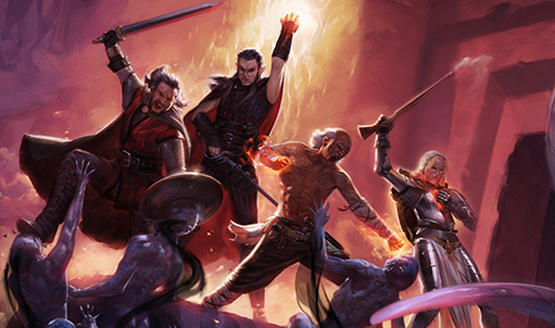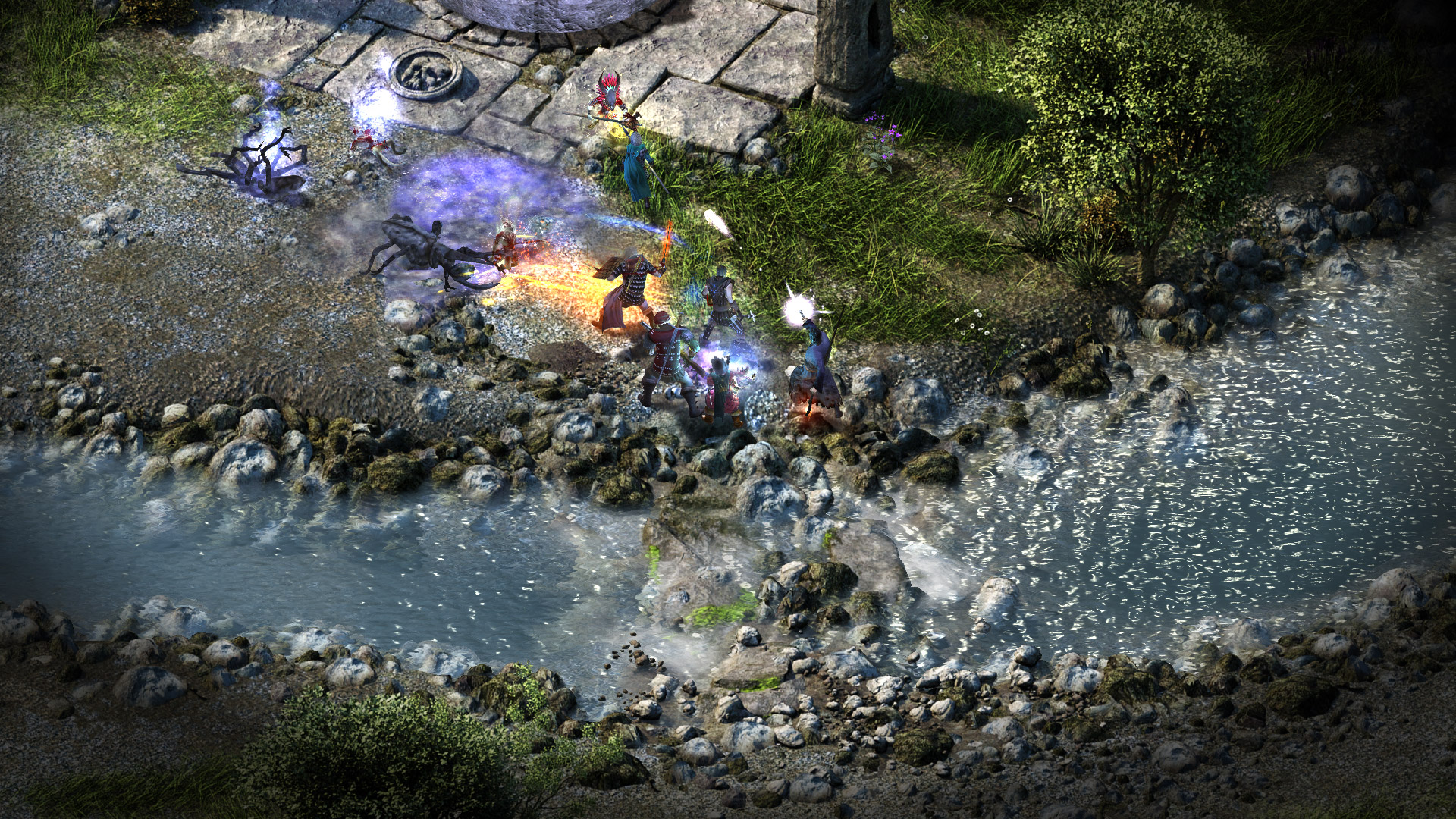
When Pillars of Eternity originally released on PC in 2015, I hailed it as a “welcome return to the cRPGs of old.” On PC, it certainly brought me back to the hardcore computer role-playing games I loved in the 90s, such as Baldur’s Gate and Icewind Dale. I never once imagined it would be brought to console, even though Divinity: Original Sin found its way there. Obsidian themselves said at E3 in 2015, to a private room of press regarding their first White March expansion, that there were absolutely no plans to bring the game to console. They said, and I quote, that it “would be too much work” and “we built this game with strictly PC in mind.” Well, I suppose never say never, as it is most certainly here, on console, in its isometric, cRPG glory. While I’m sure the story remains as deep and riveting as ever, how well does it translate to console? Color this reviewer both stoked and lucky to review this fantastic RPG twice, especially since all of the White March expansions are packaged in!
A Pillar of the RPG Genre
From the very beginning, you will know you have a special RPG in your hands, because it will take you at least 30 minutes to create your character. It’s more than simply designing the facial features, the perfect hair highlights, or just how high the browline needs to be raised. In this character creation, you’ll go more in depth about your character’s background, history, race, class, region, talents, and religion than in a round of DnD. It’s easy to get overwhelmed by all the options, especially when the races divide to even more distinct sub-races. I knew I wanted to be an elf, because I’m always a Paladin in most cRPGs. But it’s not so simple to just pick an elf; do you want to be a Wood Elf or a Pale Elf? Well Wood Elves hail from these certain regions, have these options for beliefs, and excel at these specific classes. Same goes for Pale Elves. You’ll certainly find your traditional races and classes, but Pillars of Eternity opens up unique classes, such as the cipher (essentially a psyker) and twists on races such as the Aumaua, a giant-like people who aren’t really giants.
Once you finally finish your character (there should seriously be a trophy just for building one), you start the adventure the same way most RPGs do: on a journey to somewhere new. And guess what? Something has gone wrong. Also, much to everyone’s surprise, your character becomes blessed/cursed with a new ability by accident that could lead them to save the world or destroy it! I know you’ve never heard that type of plot before.
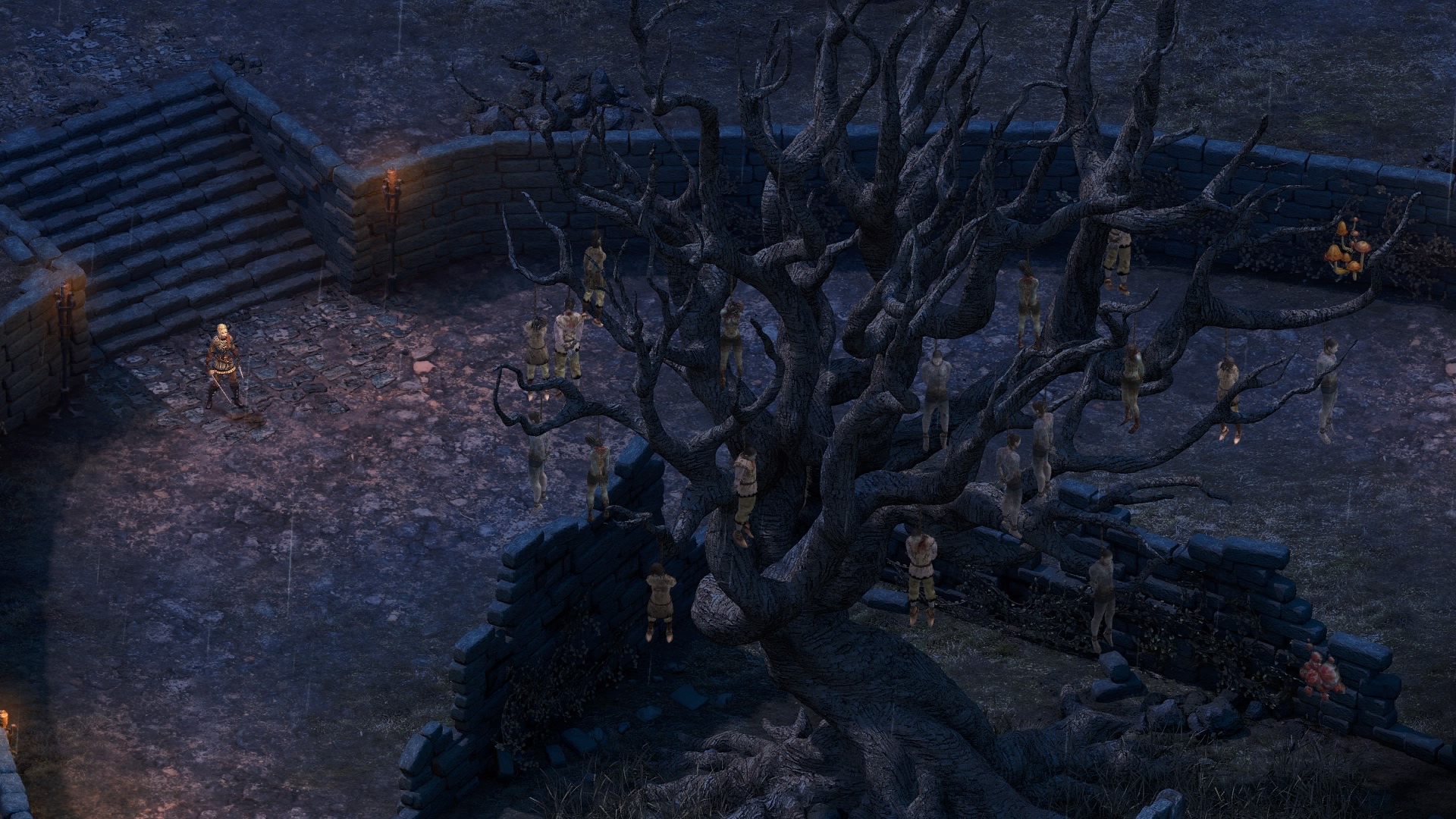
That said, like most RPGs, the uniqueness of the plot comes from how you get from the beginning to the very end, as well as the various stories you choose to unfold. From the time of the character’s Awakening, every decision you make impacts the world around you. Most importantly, it impacts how people view and treat you. Sure, you can go on a mass murder spree and kill everything and everyone you can, but you’ll have a hard time finding an inn that will let you stay there or merchants who are willing to sell their goods. The race and class you choose affects the dialogue choices available as well as your reputation. Most people don’t trust orlans, a little gnome race, but everyone loves a Paladin.
How you resolve a side quest has a bit of a lasting impact as well. For instance, I met a young boy who offered to trade a secret for a special blade one could only buy from a particular merchant. The merchant won’t sell it to him because of his age. I chose to get the blade for him, and the next time I passed by his house, his father was demanding to know where he got it. I was honest and said I did because the boy wanted to be a knight. Later on, I heard the town crier saying that a boy cut off half his fingers playing with a knight’s blade. The secret the boy had wasn’t even that great to begin with. Oh how guilty I felt in between snickers. This example was rather minor, but it did negatively impact my party’s reputation in that city. Other side quests have far bigger repercussions, such as dethroning the tyrant of Gilded Vale for a new lord, his cousin.
Dial Down the Menus
One of the biggest questions I had for the port was how it was going to handle all of the menus. It’s fairly simple in the PC version, as you just point-and-click or point-and-right-click what you want and what you need. But you can’t really do that here. I thought they were going to use the touchpad as a bit of a mouse, but instead Obsidian created two radial dials for players to peruse—one for combat and one for character tasks, such as setting equipment, reading your journal, or upgrading the stronghold. Each is activated by the L2/R2 buttons. For those who have experience with Dragon Age: Origins, this will look all too familiar, albeit a bit more complicated.
Most of the time, the distinctive radial dials make sense as to which actions will be on each one. However, I could not, for the life of me, figure out how to talk to my party members. On PC, I could just click on their character portrait. But there’s no option to do that here. It’s not in any of the character menus at all. I know, because I tried every single one, even for my stronghold, which I know wouldn’t have it. I finally went to the Pillars forum and looked it up. Of course only the PC instructions were there, but one moderator mentioned going to a combat abilities menu. Sure enough, it was in the combat radial dial. I’m not sure why I didn’t think of looking in combat when I just wanted to talk to my party.
Using the radial dials in combat isn’t exactly a treat, either. Combat is a real-time turn-based affair, with the ability to pause the action at any time to dole out commands. This style of combat has a steep learning curve to begin with, and it’s not ideal for console gameplay. Yes, you can pause at any time, but the action moves quickly. One mistake in ordering a command quickly enough can wipe out the whole party. Fortunately, Obsidian has added numerous options available for automatically triggering the pause. One of them is by opening any radial dial. This, in itself, is an absolute life-saver. No need to remember to pause the action before perusing your library of abilities to see what would be best, how many uses you have left, or what the potential areas of effect could be. You have no idea how many times forgetting to hit that space bar before searching through abilities produced a game over screen for me.
You’ll need that lovely pause with the radial dial, because you have tiers upon tiers of dials to comb through for your quick items (ironic, that one), levels of spells, and abilities. Picking favorites to put in the top layer for easy access helps, but your favorite isn’t always going to be what you need. I pretty much gave up at doling orders to my party save for the priest and mages. I might order them to move here or there, or attack this guy instead of that spider, but clicking through the dials for each character is an absolute beating.
Little From Column A, a Little From Column B
For a cRPG like this to translate to console, the radial dials are definitely a necessary evil. BioWare had to do something similar with Dragon Age: Origins between PC and console as well. I don’t like them, but I can deal with them. Outside of them, the shift to console definitely has its pluses and its minuses.
The biggest plus is moving the party. The analog stick beats clicking a mouse any day of the week. Even looking around a map is far more fluid with the right analog stick than it is with a mouse.
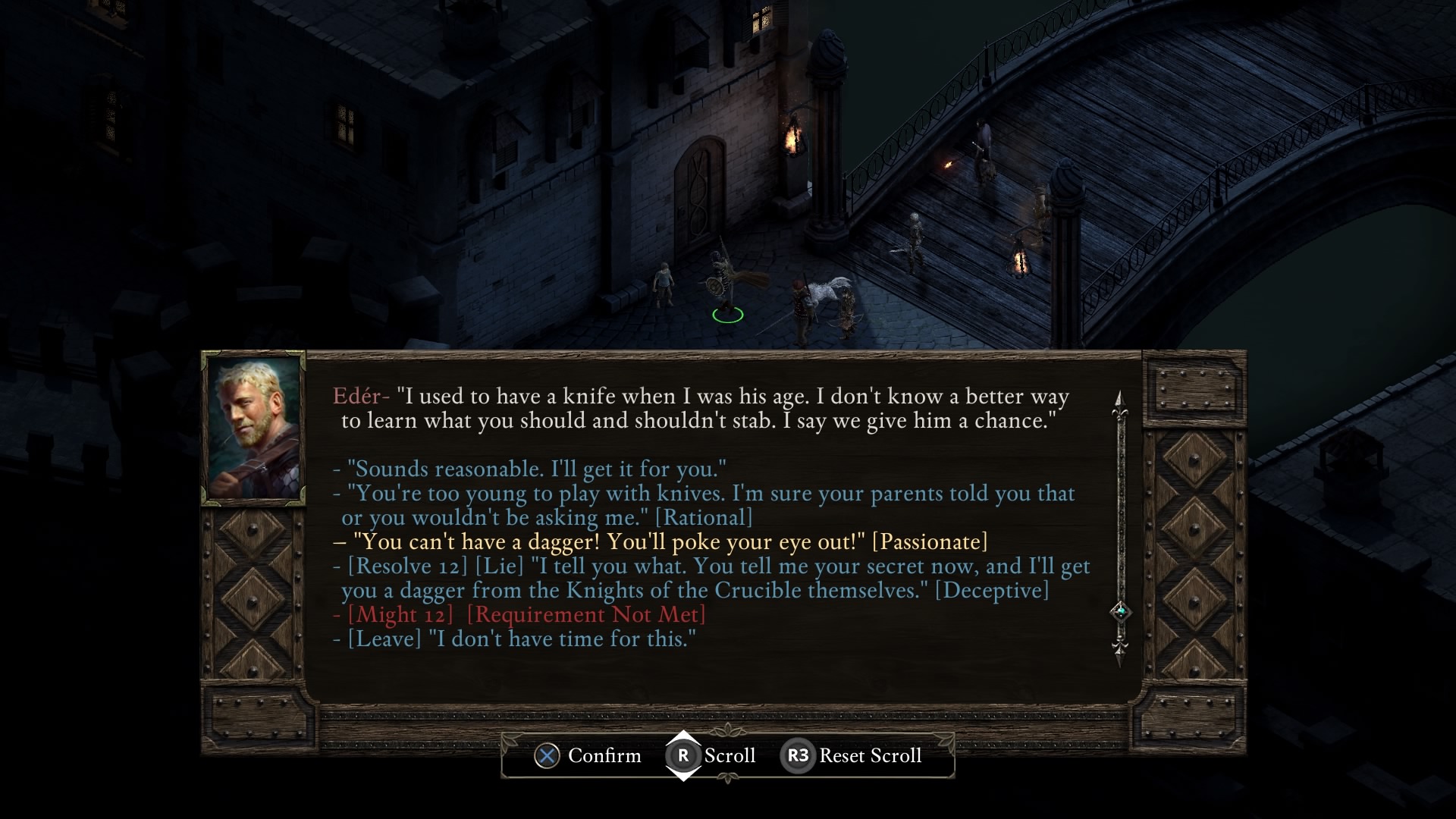
On the flip side, though, manipulating the camera is extremely limited in the console version. You have an isometric view of the party, which is an angled, top-down view. It’s often imperative to be able to move the camera to look at all angles, especially when trying to order characters to attack or use a spell on a particular enemy. That’s no longer an option. The console version also doesn’t allow a deep zoom in (which I liked to do to really look at my characters) or a long zoom out (nice for quickly finding enemies before you trigger them).
Another massive plus is the ease of searching for treasures in rooms. There’s no hovering your mouse over everything in sight, hoping the cursor will change and signal a treasure or a trap within. The party walks in a room, and items are instantly marked. Face the party or a party member toward one, tap X, and search is complete. I was worried the console version would force characters to physically move to each and every nook and cranny of an area to find something. I’m so thankful that wasn’t the case.
A Pillar of Creativity
None of these gameplaying mechanics mar the brilliance behind Pillars of Eternity in the least. None of it changes the fact that PoE presents unique approaches to puzzle solving or options for infiltrating a compound. If players uncover one of these options, a scroll-like scene appears with a few options. In the case of finding a way to sneak into a fortress, your party’s attributes will come into play for both the options of what is available as well as your success in completing your choice. Climbing a vine up a wall is find for a warrior and an aumaua, but dwarves will easily fatigue, requiring rest.
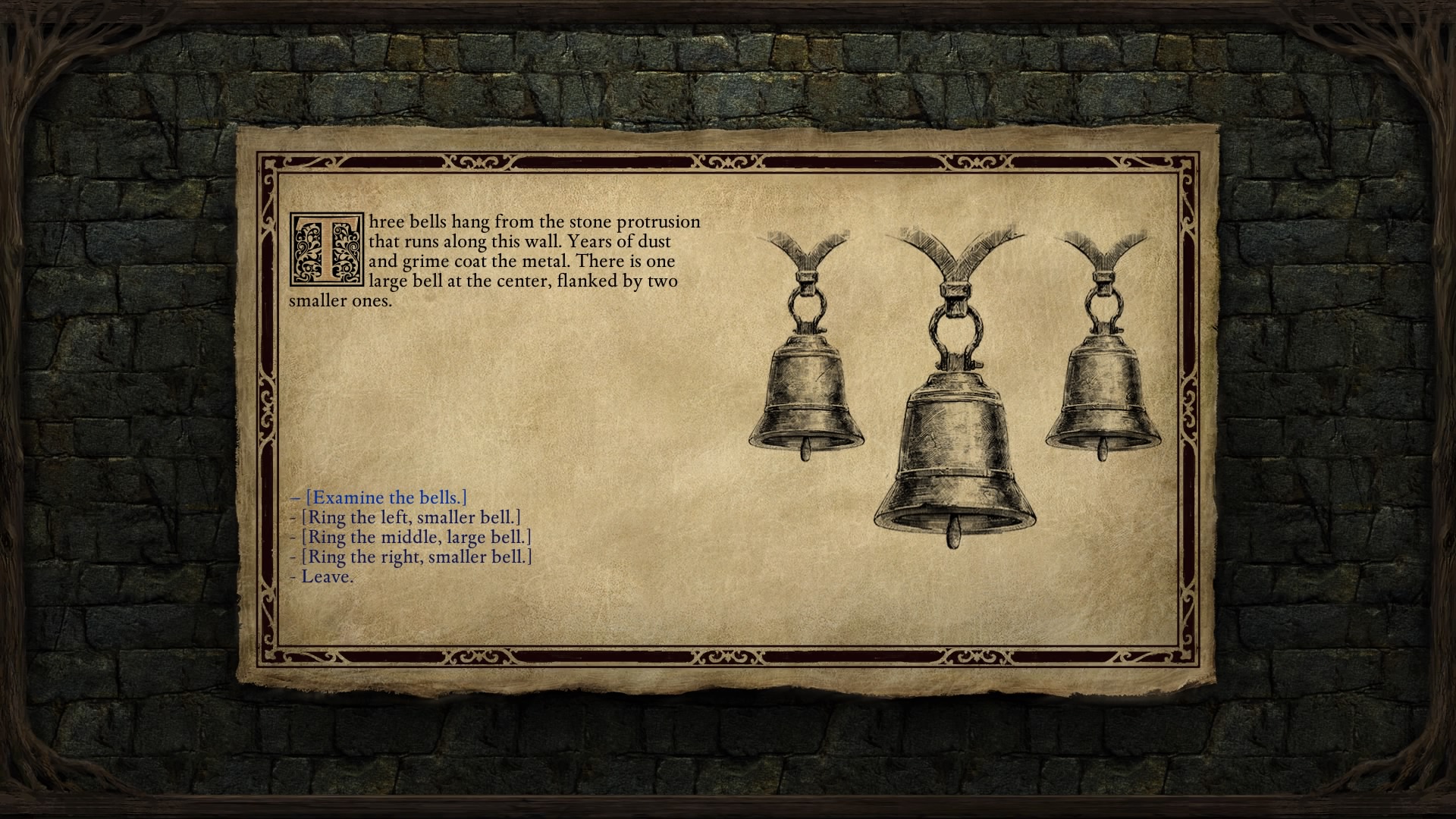
In addition, you’ve most likely never seen party management like this. Each party member has a health bar and endurance. If a companion loses all endurance in a fight, they’re knocked out and won’t revive until the end of the fight or if another character brings them back. Depending upon the damage taken in the fight, the character will lose health too. If all health is lost, the character becomes maimed. If the character is knocked out while maimed, it’s permadeath. In the higher difficulties, sometimes maiming never happens and you go straight to the Pale Knight. Resting is more important in PoE than I’ve ever had in any other RPG, because no potion will heal health or an injury. Some potions will give back endurance, but those can only be consumed while in combat. It’s a lot to juggle at times, which intensifies the combat experience. Despite this, it’s never really overwhelming, though, thanks to that pause button.
Pillars of Eternity was certainly crafted with PC in mind, but it’s no less an enjoyable experience on console. I admit I came in with a bit of a bias having played it on PC first, and I had those expectations coming in, fair or not. Yes, I missed a mouse and keyboard with item management and combat, but as a whole, I’m incredibly impressed with how Obsidian has managed to translate this hardcore cRPG to console. More than anything, I’m thrilled that console gamers now have the opportunity to romp through Eora. It’s an adventure no RPG-fan should miss.
Pillars of Eternity: Complete Edition review code provided by publisher. For more information on scoring please see our Review Policy here.
-
Gameplay versatility
-
Unique approaches to solving puzzles
-
Deep story
-
White March expansion inclusion
-
Analog sticks improve movement and looking around
-
Radial dials for menus
-
Limited camera manipulation
